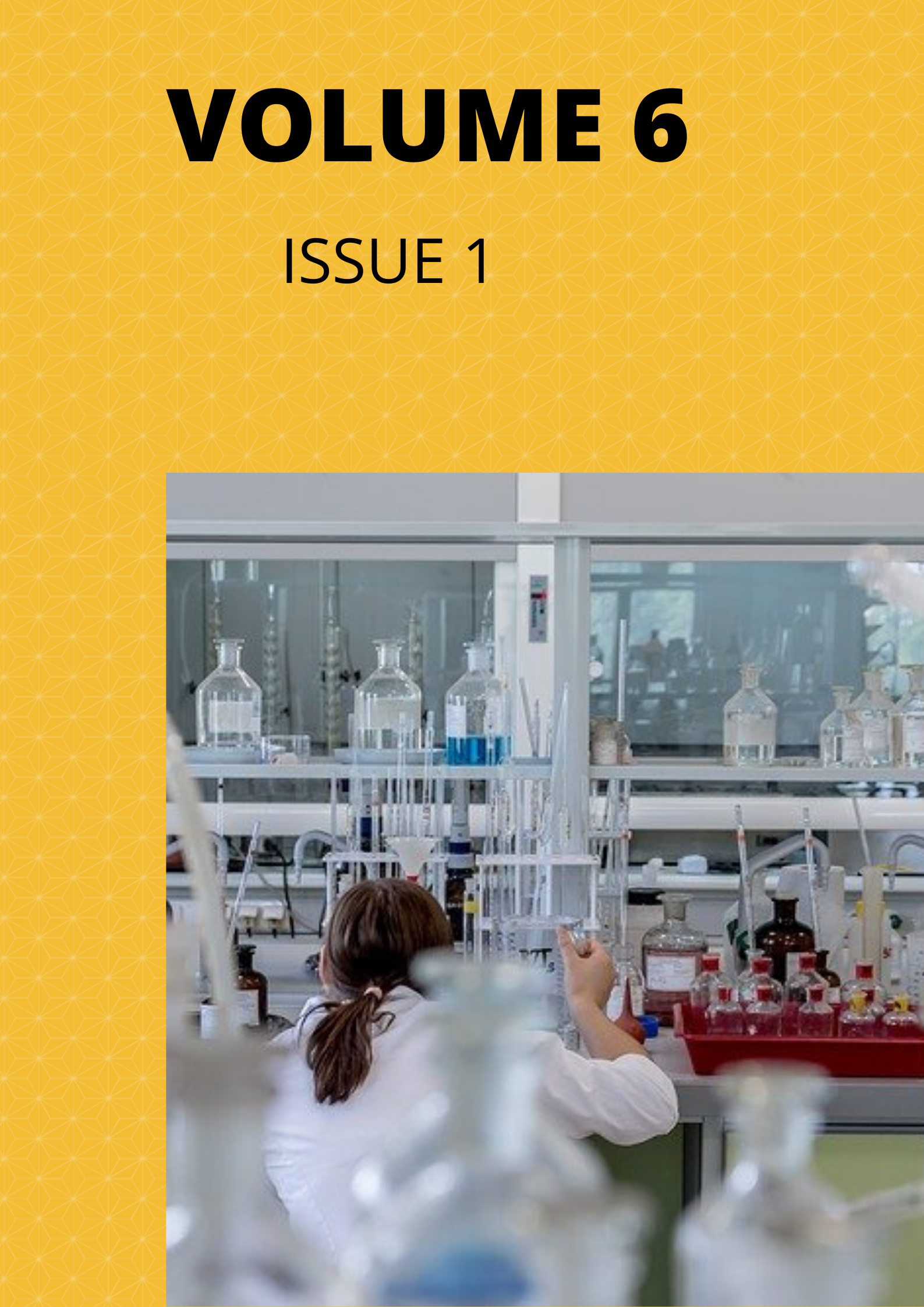Synthesis of an azo dye and its cobalt complex derived from 3-aminophenol
Keywords:
Azo dye, ligand, cobalt complex, 3-aminophenolAbstract
An azo dye derived from 3-aminophenol and its cobalt complex have been synthesized and characterized using Fourier transformed and ultraviolet visible spectrophotometer. The ligand (dye) exhibited an absorption maximum at 470 nm but the absorbance maxima for the synthesized Schiff base complex deviated from 470 to 473 nm which indicated the existent of interaction between the cobalt and the ligand to form metal-dye complex. Moreover, the infrared absorbance band for -N=N- stretching vibration at 1513.3 cm-1 for azo dye nut in the complex the frequency shifted to 1457.4 cm-1. The calculated percentage yield of the azo dye was found to be 84% while that of its cobalt complex was 59%.
Downloads
Published
Issue
Section
Most read articles by the same author(s)
- Gideon Wyasu, Production of Activated carbon derived from Banana peel for the removal of Cd2+ and Cr6+ in Brewery wastewater , Communication In Physical Sciences: Vol. 3 No. 1 (2018): VOLUME 3 ISSUE 1
- Gideon Wyasu, Batch adsorption of Hg2+ and As3+ ions in Hospital wastewater using activated carbon from Balanites aegyptiaca and Detarium microcarpum , Communication In Physical Sciences: Vol. 5 No. 4 (2020): VOLUME 5 ISSUE 4
- Gideon Wyasu, Determination of Bacteriological and some physicochemical properties of Hospital wastewater , Communication In Physical Sciences: Vol. 4 No. 2 (2019): VOLUME 4 ISSUE 2
- Nathaniel Atamas Bahago, Gideon Wyasu, Sorption Studies of Methylene Blue Using Activated Carbon Produced from Rice Husk , Communication In Physical Sciences: Vol. 3 No. 1 (2018): VOLUME 3 ISSUE 1
- Gideon Wyasu, The influence of natural fermentation, malt addition and soya fortification on the sensory and physio-chemical characteristics of gyok-millet gruel , Communication In Physical Sciences: Vol. 4 No. 1 (2019): VOLUME 4 ISSUE 1
- B. Myek, S. O. Idris, A. D. Onu, M. K. Yakubu, Kinetics and Mechanism of the Oxidation of Orange II by Chlorate Ion in Aqueous Hydrochloric Acid , Communication In Physical Sciences: Vol. 5 No. 2 (2020): VOLUME 5 ISSUE 2
- B. Myek, M. L. Batari, J. O. Orijajogun, M. A. Aboki, Synthesis and Characterization of Metal Complex of an Azo Dye Based on Acid Orange 7 , Communication In Physical Sciences: Vol. 5 No. 3 (2020): VOLUME 5 ISSUE 3
- Nathaniel Atamas Bahago, Gideon Wyasu, Mary Gojeh, Optimization of Activated Carbon Preparation from Corncob Wastewater Treatment , Communication In Physical Sciences: Vol. 7 No. 2 (2021): VOLUME 7 ISSUE 2
- Gideon Wyasu, Batch adsorption of Mn2+ and Co3+ from Refinery wastewater using activated carbon from epicarp of Detarium microcarpum and Balanites aegyptiaca shells , Communication In Physical Sciences: Vol. 3 No. 1 (2018): VOLUME 3 ISSUE 1
Similar Articles
- B. Myek, M. L. Batari, J. O. Orijajogun, M. A. Aboki, Synthesis and Characterization of Metal Complex of an Azo Dye Based on Acid Orange 7 , Communication In Physical Sciences: Vol. 5 No. 3 (2020): VOLUME 5 ISSUE 3
- Ndidiamaka Justina Agbo, Pius Oziri Ukoha, Uchechukwu Susan Oruma, Tania Groutso, Oguejiofo Theophilus Ujam, Solomon Ejike Okereke, Crystal Structure, in Silico Studies and Anti-diabetic Potentials of 3-e-(1,5-dimethyl-3-oxo-2-phenyl-2,3-dihydro-1h-pyrazol-4-yl)hyd -razinylidene]pentane-2,4-dione(hdpp)and its Cu(II) and Ni(II) complexes , Communication In Physical Sciences: Vol. 11 No. 4 (2024): VOLUME 11 ISSUE 4
- Ifeanyi E. Otuokere, K. K. Igwe, Ni(II) complex of (3,3-dimethyl-7-oxo-6-(2-Phenylacetamido)-4-thia1-Azabicyclo[3.2.0]heptane-2-carboxylic acid : Synthesis, characterization and antibacterial activities , Communication In Physical Sciences: Vol. 5 No. 1 (2020): VOLUME 5 ISSUE 1
- Uchechukwu Susan Oruma, Pius Oziri Ukoha, Lawrence Nnamdi Obasi, Synthesis, Characterization and Biological Studies of Trinuclear Ce(IV) Salen Capped Complex with 5-amino-2,4,6-tris(4-carboxybenzimino)-1,3-pyrimidine , Communication In Physical Sciences: Vol. 5 No. 3 (2020): VOLUME 5 ISSUE 3
- Unwanaobong Friday Robert, Ifeanyi Edozie Otuokere, Jude Chodozie Nnaji, Synthesis, Characterization, and ADME/T Prediction of (2Z)-2-[2-(2,4-Dinitrophenyl)hydrazinylidene]-1,2-diphenyle -than-1-ol (DPHD) and Its Copper(II) Complex , Communication In Physical Sciences: Vol. 12 No. 7 (2025): Volume 12 issue 7
- Ifeanyi E. Otuokere, J. C. Anyanwu, K. K. Igwe, Ni(II) Complex of a Novel Schiff Base Derived from Benzaldehyde and Sulphathiazole: Synthesis, Characterization and Antibacterial Studies , Communication In Physical Sciences: Vol. 5 No. 2 (2020): VOLUME 5 ISSUE 2
- Izuagbe Gilbert Osigbemhe , Muluh Emmanuel Khan, SYNTHESIS, SPECTROSCOPIC CHARACTERIZATION AND BIO-INVESTIGATION of N-(2-furylmethylidene)-1,3, 4-thiadiazole-2-amine and its Iron (III) COMPLEXES , Communication In Physical Sciences: Vol. 12 No. 4 (2025): VOLUME1 2 ISSUE 4
- Nsikanabasi Ekerete Nkom, Ededet Akpan Eno, Atim Sunday Johnson, Idongesit Bassey Anweting, SYNTHESIS AND CHARACTERIZATION OF 4- AMINO-3-MERCAPTO-5-METHYL-1, 2, 4 -TRIAZOLE AND ITS MIXED- LIGANDS COMPLEX WITH Cd (II) IONS , Communication In Physical Sciences: Vol. 12 No. 6 (2025): Volume 12 ISSUE 6
- Ifeanyi E. Otuokere, J.C. Anyanwu, K.K. Igwe, Synthesis, Spectra and Antibacterial Studies of 4-{[(E)-phenylmethyl- idene]amino}-N-(1,3-thiazol-2-yl)benzenesulfonamide Schiff Base Ligand and its Ni(II) Complex , Communication In Physical Sciences: Vol. 7 No. 2 (2021): VOLUME 7 ISSUE 2
- Ifeanyi E. Otuokere, K. K. Igwe, Chelating and Antibacterial Potentials of Benzylpenicillin and its Ni(II) Complex , Communication In Physical Sciences: Vol. 8 No. 2 (2022): VOLUME 8 ISSUE 2
You may also start an advanced similarity search for this article.




